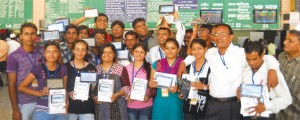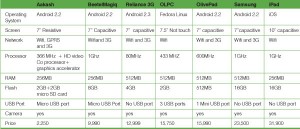
By Pragya Gupta
India’s demographic diversity has always been a challenge for access to education. The concept of low cost tablet gives a ray of hope to impart education access and opportunities to all, thereby bringing about an inclusive education system
Information and Communication technologies have been recognised as revolutionary tools that can leverage India’s demographic advantage and turn the country into a knowledge powerhouse by nurturing and honing the knowledge base. Various policies have been launched to improve access, equity and enhance quality of education across the country. National Mission on Education through ICT (NME-ICT), launched by Ministry of Human Resource Development in February 2009 is one of them. The Mission has a budget of INR 4612 crore. The National Mission on Education – Sakshat comprises of 48 components structured broadly around building content, enabling access and developing low cost access cum computing devices.
 Despite having content available on cloud and accessible to all, India still lags behind in making content available. One of the major reasons for this is the unavailability of devices in terms of affordability for all.
Despite having content available on cloud and accessible to all, India still lags behind in making content available. One of the major reasons for this is the unavailability of devices in terms of affordability for all.
Tablet Driven Education
More than 70,000 ebooks are used now in 1500 colleges, a fact that highlights the increasing adoption and acceptability for e-content. With ever-increasing numbers, there is a need for a device which can offer content in a user-friendly and innovative manner. Tablets fulfil these criteria to a large degree, a fact reflected in the increasing acceptability of the devices in the education segment. A large variety of customised tablets are now available, with big vendors like Samsung, HCL, Dell, Motorola, etc., coming out with their offerings. Starting at a low price of INR 10,000 the market now offers sufficient choices that suit a variety of pockets and needs.
The tablet, initially considered more of lifestyle device, is steadily evolving over time and is increasingly being looked at as a potential device for enhancing accessibility of education, if available at lower price points. Starting with the vision of the OLPC project – that of making laptops available for a measly $100 – technological innovation is resulting into affordable devices that can drive growth in developing countries.
Low cost, technology-enabled education is the need of the hour and is perhaps the only feasible manner in which the ocean of knowledge can be accessed by anyone, anywhere and at anytime, even without access to teachers or other traditional infrastructure needed for education. It creates a pull of information for those who really want to learn by eroding the issues like unavailability of resources and inaccessibility of schools and college. Even the best e-content cannot have significant impact unless it reaches the vast majority of learners with ease, as and when they demand it. The low cost access and computing devices enable knowledge and students to access one another, and also enable collaborative learning. Although there are low cost options such as desktop virtualisation, low cost PCs etc., but their reach and affordability to a larger section is still a challenge.
The ultra low cost tablet Aakash recently launched by Kapil Sibal, Union Minister for Human Resourced development is a $ 35 dollar access cum computing device. Datawind is manufacturing and supplying Aakash tablets in India. While the subsidised version would be restricted to students only, the tablets will be made available to general consumers with the name of Ubislate.
A Digital Dawn
Aakash tablet is targeted at secondary and higher education. The Government is eyeing children across the world to make education accessible to all. The Indian Institute of Technology Rajasthan has played an important role in the project, completed under the NME-ICT.
Questions had been asked over the economic feasibility of the devices at the cost of USD 35 announced by Kapil Sibal. The lowest bidder quoted an ex-factory price of US$ 37.98 which was close to the cost mentioned by HRM. The cost comprised of the costs of components, material as well as those of manufacturing expenses. The final landed price of $49.98/unit (which translated to INR 2276 at the exchange rate at the time of the order) included taxes, levies, and charges like freight, insurance, servicing and documentation, etc. The landed price also includes one-year free replacement warranty from the manufacturer.
The development of this device has been done in India plant at Hyderabad by a private vendor DataWind. Suneet Singh Tuli,CEO, DataWind said, “Our goal was to break the price barrier for computing and Internet access. Working with IIT Rajasthan, and NME-ICT, we have created a product that will finally bring affordable computing and Internet access to the masses. This is not only a concept that applies to India, but has ignited the imagination of governments around the world. The Aakash is proudly made in India, and is destined to revolutionise computing and Internet access for the world.”
 Reality Check
Reality Check
Using this device, learners will be able to access all the thousands of items of content available on the Sakshat portal and other educational web-sites. But initially each state will get 3300 devices and these devices will be given to identified state coordinators for testing. These state coordinators will be asked to submit their report on these devices and according to these reports, government will take further action. This device was also distributed amongst 500 children at the launch itself. Sibal underlined that Aakash would help in eliminating digital illiteracy. For this he also emphasised the need for having high quality study content to be made accessible to students. He also called for support and partnership from all the stakeholders so that the device could cost even less, while praising the team which had worked towards the creation and production of this device.
Dr Prem Kalra, Director of IIT Rajasthan quoted in a website said that Aakash was an inspiration and encourages entrepreneurship in a big manner. “It’s true, there are glitches. This (the event) too is a field test. The state coordinators will take the tablets for field testing all around the country.”
With the launch of the tablet, criticism from competitors have also started. Satish Jha, OLPC criticising the product said that the tablet is for colleges and urban areas, it doesn’t address the constituency OLPC India Foundation targets – the underprivileged kids. It has no ambition to give education at all. It is just a cheap device, an access device. It is a consumption device, not an educational, creative or production device.

“Our goal was to break the price barrier for computing and Internet access”
Suneet Singh
CEO, DataWind
On the price front, Jha claims they can produce a sub-$100 version of the OLPC. “We can produce an OLPC for less than $100 if we just remove the swivel and a few features. But we don’t do that because a child needs a complete environment to learn, it is a school in a box. The $35 device meets the expectation of somebody who wants to manufacture the device but not the needs of the users,” he complained.
While the market may have many tablets with better configuration but even then their performance comes down as soon as they are fully loaded with applications. In urban areas, students prefer laptops more than tablet for education as they are multipurpose devices at the same price point. Tablet is more of handheld device, which, with its limited performance, is a craze among students as a lifestyle device.
However, low cost device make sense in rural areas but connectivity is the challenge there. Devices can be made available but connectivity incurs charges, which should also be taken care of by the government and private sector.




















